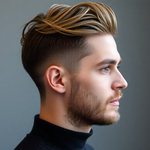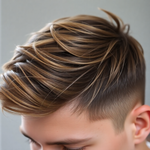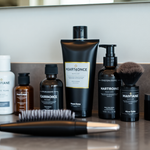
Color-First Dressing: Use Semi‑Permanent Hair Color to Maximize Mix-and-Match Options in a Sustainable Men's Capsule Wardrobe
31 August 2025
Share
Hook: Fewer pieces, bolder impact
Struggling to make a small wardrobe feel like a million bucks? Color-First Dressing: Use Semi‑Permanent Hair Color to Maximize Mix-and-Match Options in a Sustainable Men's Capsule Wardrobe is a simple strategy that turns hair into a styling tool. In under 10 minutes of planning you can make existing pieces coordinate better, reduce impulse buys, and build a capsule that lasts through seasons.
What is color-first dressing and why it matters
Color-first dressing treats your hair hue as an intentional layer of every outfit. Instead of reacting to clothes, you design garments and accents to work with your hair anchor. That approach improves visual cohesion and makes mixing-and-matching feel deliberate rather than random. For men who prefer minimal wardrobes, this method multiplies outfit possibilities without multiplying purchases.
Color-First Dressing: Use Semi‑Permanent Hair Color to Maximize Mix-and-Match Options in a Sustainable Men's Capsule Wardrobe
Using this exact approach—Color-First Dressing: Use Semi‑Permanent Hair Color to Maximize Mix-and-Match Options in a Sustainable Men's Capsule Wardrobe—means choosing semi-permanent hair color so you can test tones, adjust for seasons, and keep a low-impact routine. Semi-permanent dye fades naturally, reduces long-term chemical exposure, and is easier to pair with sustainable clothing choices.
Why semi-permanent hair color is the perfect match for a capsule wardrobe
- Low commitment: Try a tone for weeks, not years. Ideal for exploring how color influences your look.
- Less damage: Generally gentler than permanent dyes, helping hair retain shine and texture that complements garments.
- Eco options exist: Many semi-permanent formulas focus on cleaner ingredients and lower waste, matching sustainable wardrobe values.
- Quick refresh: Fading gives a natural gradient over time, which can make outfits look lived-in and intentional.
Color theory basics for men who want to look sharp
Understanding a few color principles makes pairing hair and clothes effortless. You don’t need to become a designer—just keep these rules in your back pocket.
- Anchor tones: Neutrals like navy, charcoal, beige, and olive are your base. Choose a hair anchor that complements those tones.
- Temperature match: Cool hair tones (ash, cool brown) work best with cool wardrobes (navy, steel gray). Warm tones (caramel, copper) pair with earthier palettes (olive, tan).
- Accent harmony: Use 1–2 accent colors for small pieces—scarves, tees, socks—that pick up hair undertones.
- Contrast for impact: If your capsule is monochrome, a subtle tint or pastel in hair creates interest without clashing.
How to pick your hair anchor (step-by-step)
- Inspect your closet: Pull 20 core items and photograph them. Note dominant and secondary colors.
- Identify your skin tone and natural hair undertone: Are you cool, warm, or neutral? This affects which shades look most natural.
- Choose the level of change: Want subtle enhancement or an obvious statement? Semi-permanent options range from slight ash to vivid tints.
- Test a strand: Do a quick strand test or visit a stylist for a mini trial; observe the color next to typical outfits in natural light.
- Plan accent pieces: Buy or repurpose 2–3 small accessories that echo the new hair hue to reinforce cohesion.
Wardrobe templates: Color-first capsules for three common palettes
Below are tailored capsules that show how hair anchors expand outfit permutations. Each capsule contains 12–14 pieces and assumes you pick a semi-permanent hair hue that complements the listed tones.
1. Cool urban capsule (navy, gray, black)
- Hair anchor: ash brown or soft smoky blue tint
- Pieces: navy blazer, charcoal knit, white tee, black tee, dark denim, gray chinos, black boots, white minimalist sneaker, technical rain jacket, wool beanie in burgundy (accent), leather belt, compact crossbody bag.
- Styling tip: Ash tones soften contrasts and make navy and charcoal blend, so you can wear navy on navy without looking flat.
2. Earthy casual capsule (olive, tan, rust)
- Hair anchor: warm caramel, chestnut, or soft copper
- Pieces: olive field jacket, tan overshirt, white button-up, oatmeal knit, dark chinos, brown boots, suede sneakers, rust tee (accent), leather watch, rugged backpack.
- Styling tip: Warm hair adds continuity to olive and tan layers—less contrast, more flow.
3. Minimal monochrome capsule (black, white, soft gray)
- Hair anchor: soft pastel tint (faint blue or dusty purple) or subtle ash for low-key
- Pieces: black bomber, white tee, black jeans, gray overcoat, monochrome sneaker, slim black belt, lightweight knit, tonal cap, structured duffel.
- Styling tip: Let hair be the only color; it reads as intentional and modern against monochrome layers.
Building your capsule: a 6-week plan
- Week 1 — Closet audit: Photograph outfits, list 20 items you wear most, circle pieces to keep.
- Week 2 — Color mapping: Pick your hair anchor and 2 accent colors. Make a simple palette swatch sheet on your phone.
- Week 3 — Buy 1–3 targeted pieces: Replace worn basics or add small accents that reinforce your palette. Consider Menll.com’s EcoSneak for a sustainable sneaker option that fits many capsules: Menll.com EcoSneak.
- Week 4 — Strand test / salon consult: Try semi-permanent dye on a small section or see a stylist for a consult.
- Week 5 — Color application: Apply at home following safety steps or book a professional treatment for best results.
- Week 6 — Photo review & tweak: Wear different outfit combos, photograph, and tweak accent pieces as needed.
Styling recipes: 20 mix-and-match outfit ideas
Below are quick combinations you can assemble once hair and capsule are set. Swap shoes or outerwear to adapt to weather.
- Navy blazer + white tee + dark denim + white EcoSneak
- Charcoal knit + gray chinos + black boots
- Olive field jacket + rust tee + dark chinos + brown boots
- Tan overshirt + white button-up + denim + suede sneakers
- Black bomber + gray knit + black jeans + monochrome sneaker
- White tee + navy blazer + tan chinos
- Oatmeal knit + denim + brown boots
- Gray overcoat + black jeans + white tee
- Layered look: white button-up under charcoal knit + navy blazer
- Rain-ready: technical jacket + black jeans + EcoSneak
- Casual date: olive jacket + white tee + dark denim
- Weekend travel: knit + chinos + sneakers + crossbody bag
- Work-casual: navy blazer + gray chinos + leather belt
- Night out: black bomber + black jeans + leather boots
- Layered autumn: tan overshirt + olive jacket + scarf
- Summer smart: white shirt + navy chinos + loafers
- Gym-to-cafe: tee + chinos + sneakers
- Business trip: blazer + knit + dark denim
- Flight outfit: knit + sneakers + structured duffel
- Minimal weekend: monochrome tee + black jeans + beanie
Care and maintenance: protect color and clothing
Good habits extend both hair color and garment life—key to sustainability and saving money.
- Hair: Use color-safe, sulfate-free shampoos and cold or lukewarm water. Limit washes to preserve color and natural oils.
- Clothing: Wash in cold water, use gentle detergent, and air-dry when possible to prevent shrinkage and fabric stress.
- Stain prevention: Be mindful of direct contact between wet-dye-treated hair and light fabrics during the first 48 hours.
- Rotate pieces: Regularly rotate footwear and outer layers to increase longevity.
Product and ingredient guidance for semi-permanent dyes
Not all semi-permanent dyes are created equal. Look for brands that minimize harsh chemicals, provide clear ingredient lists, and offer recycling or refill programs. If you have sensitivities, do a patch test and consult a stylist. For general safety information about hair dyes and potential risks, see this overview from WebMD: WebMD: What Are Hair Dyes.
Salon or DIY: which route should you pick?
Both have pros and cons. A salon visit offers expert color placement, professional-grade formulas, and better assessment for your skin tone. DIY is cheaper and lets you experiment faster—just pick high-quality semi-permanent kits and follow instructions. If you’re nervous, book a consult and request a strand test first.
Troubleshooting common issues
- Color fades too fast: Reduce wash frequency, use cold water, and switch to color-protect products.
- Color looks muddy with outfits: Reassess accent pieces and test a contrasting accessory to reset the palette.
- Unexpected brassiness: Use a color-depositing shampoo or a toner formulated for semi-permanent hues.
- Staining on collars: Wear a dark scarf or layer during the first 48 hours after dyeing, and pre-wash new light shirts to reduce visible marks.
Sustainability checklist
To keep your color-first capsule truly sustainable, follow these quick rules:
- Prioritize durable, repairable clothing over fast fashion.
- Choose semi-permanent dyes from brands with cleaner formulas and minimal packaging.
- Use refillable or concentrated hair care products.
- Donate or trade pieces you no longer wear rather than discarding them.
Budgeting: how color-first dressing saves money
Investing in a small number of high-quality pieces and using semi-permanent hair color to expand outfit options beats continually buying trend pieces. Expected costs:
- One semi-permanent dye kit or salon session: modest one-time cost that lasts weeks.
- 3 targeted wardrobe upgrades: typically lower total spend than replacing an entire season’s worth of clothes.
- Care products designed to extend life of both clothing and color pay dividends long-term.
Seasonal tweaks: adapting your hair anchor and capsule
Switching hair tone slightly each season keeps looks fresh. Try warming tones in fall and colder tints in spring. Seasonal swaps in the capsule—lighter knits for summer, heavier outerwear for winter—extend use without new core purchases.
Final checklist before you start
- Photograph current wardrobe and pick dominant tones.
- Choose a semi-permanent hair anchor and do a strand test.
- Buy 1–3 accent or replacement pieces that reinforce the new palette.
- Adopt hair and garment care routines that extend life and color.
- Document outfits and refine over 4–6 weeks.
Wrap-up and soft call-to-action
Color-First Dressing: Use Semi‑Permanent Hair Color to Maximize Mix-and-Match Options in a Sustainable Men's Capsule Wardrobe is a practical way to make fewer, better pieces work harder. Start small—test a shade, add a single accent, and watch your outfit options multiply. Which hair anchor are you curious to try first? Share your pick below or explore Menll.com’s sustainable collections to find pieces that pair perfectly with your new color-forward approach.
Prev post

Boost Closet Versatility: How Semi‑Permanent Hair Color Extends a Sustainable Men's Capsule Wardrobe
Updated on 01 September 2025
Next post

Match Your Mane: Use Semi‑Permanent Hair Color to Build a Sustainable Men's Capsule Wardrobe
Updated on 30 August 2025





